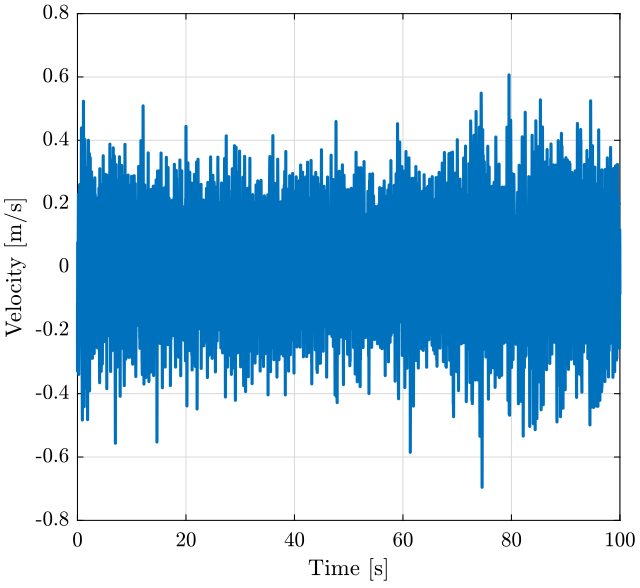Compute Spectral Densities of signals with Matlab
Table of Contents
This document presents the mathematics as well as the matlab scripts to do the spectral analysis of a measured signal.
Typically this signal is coming from an inertial sensor, a force sensor or any other sensor.
We here take the example of a signal coming from a Geophone measurement the vertical velocity of the floor at the ESRF.
1 Sensitivity of the instrumentation
The measured signal \(x\) by the ADC is in Volts. The corresponding real velocity \(v\) in m/s.
To obtain the real quantity as measured by the sensor, one have to know the sensitivity of the sensors and electronics used.

Figure 1: Schematic of the instrumentation used for the measurement
2 Convert the time domain from volts to velocity
Let's say, we know that the sensitivity of the geophone used is \[ G_g(s) = G_0 \frac{\frac{s}{2\pi f_0}}{1 + \frac{s}{2\pi f_0}} \quad \left[\frac{V}{m/s}\right] \]
G0 = 88; % Sensitivity [V/(m/s)] f0 = 2; % Cut-off frequency [Hz] Gg = G0*(s/2/pi/f0)/(1+s/2/pi/f0);
And the gain of the amplifier is 1000: \(G_m(s) = 1000\).
Gm = 1000;
If \({G_m(s)}^{-1} {G_g(s)}^{-1}\) is proper, we can simulate this dynamical system to go from the voltage to the velocity units (figure 2).
data = load('mat/data_028.mat', 'data'); data = data.data; t = data(:, 3); % [s] x = data(:, 1)-mean(data(:, 1)); % The offset if removed (coming from the voltage amplifier) [v] dt = t(2)-t(1); Fs = 1/dt;

Figure 2: Schematic of the instrumentation used for the measurement
We simulate this system with matlab:
v = lsim(inv(Gg*Gm), v, t);
And we plot the obtained velocity
figure; plot(t, v); xlabel("Time [s]"); ylabel("Velocity [m/s]");

Figure 3: Measured Velocity
3 Power Spectral Density and Amplitude Spectral Density
We now have the velocity in the time domain: \[ v(t)\ [m/s] \]
To compute the Power Spectral Density (PSD): \[ S_v(f)\ \left[\frac{(m/s)^2}{Hz}\right] \]
To compute that with matlab, we use the pwelch function.
We first have to defined a window:
win = hanning(ceil(10*Fs)); % 10s window
[Sv, f] = pwelch(v, win, [], [], Fs);
figure; loglog(f, Sv); xlabel('Frequency [Hz]'); ylabel('Power Spectral Density $\left[\frac{(m/s)^2}{Hz}\right]$')
The Amplitude Spectral Density (ASD) is the square root of the Power Spectral Density:
\begin{equation} \Gamma_{vv}(f) = \sqrt{S_{vv}(f)} \quad \left[ \frac{m/s}{\sqrt{Hz}} \right] \end{equation}figure; loglog(f, sqrt(Sv)); xlabel('Frequency [Hz]'); ylabel('Amplitude Spectral Density $\left[\frac{m/s}{\sqrt{Hz}}\right]$')
4 Modification of a signal's Power Spectral Density when going through an LTI system

Figure 4: Schematic of the instrumentation used for the measurement
We can show that:
\begin{equation} S_{yy}(\omega) = \left|G(j\omega)\right|^2 S_{xx}(\omega) \end{equation}And we also have:
\begin{equation} \Gamma_{yy}(\omega) = \left|G(j\omega)\right| \Gamma_{xx}(\omega) \end{equation}5 From PSD of the velocity to the PSD of the displacement

Figure 5: Schematic of the instrumentation used for the measurement
The displacement is the integral of the velocity.
We then have that
\begin{equation} S_{xx}(\omega) = \left|\frac{1}{j \omega}\right|^2 S_{vv}(\omega) \end{equation}Using a frequency variable in Hz:
\begin{equation} S_{xx}(f) = \left| \frac{1}{j 2\pi f} \right|^2 S_{vv}(f) \end{equation}For the Amplitude Spectral Density:
\begin{equation} \Gamma_{xx}(f) = \frac{1}{2\pi f} \Gamma_{vv}(f) \end{equation}Now if we want to obtain the Power Spectral Density of the Position or Acceleration: For each frequency: \[ \left| \frac{d sin(2 \pi f t)}{dt} \right| = | 2 \pi f | \times | \cos(2\pi f t) | \]
\[ \left| \int_0^t sin(2 \pi f \tau) d\tau \right| = \left| \frac{1}{2 \pi f} \right| \times | \cos(2\pi f t) | \]
\[ ASD_x(f) = \frac{1}{2\pi f} ASD_v(f) \ \left[\frac{m}{\sqrt{Hz}}\right] \]
\[ ASD_a(f) = 2\pi f ASD_v(f) \ \left[\frac{m/s^2}{\sqrt{Hz}}\right] \] And we have \[ PSD_x(f) = {ASD_x(f)}^2 = \frac{1}{(2 \pi f)^2} {ASD_v(f)}^2 = \frac{1}{(2 \pi f)^2} PSD_v(f) \]
Note here that we always have \[ PSD_x \left(f = \frac{1}{2\pi}\right) = PSD_v \left(f = \frac{1}{2\pi}\right) = PSD_a \left(f = \frac{1}{2\pi}\right), \quad \frac{1}{2\pi} \approx 0.16 [Hz] \]
If we want to compute the Cumulative Power Spectrum: \[ CPS_v(f) = \int_0^f PSD_v(\nu) d\nu \quad [(m/s)^2] \]
We can also want to integrate from high frequency to low frequency: \[ CPS_v(f) = \int_f^\infty PSD_v(\nu) d\nu \quad [(m/s)^2] \]
The Cumulative Amplitude Spectrum is then the square root of the Cumulative Power Spectrum: \[ CAS_v(f) = \sqrt{CPS_v(f)} = \sqrt{\int_f^\infty PSD_v(\nu) d\nu} \quad [m/s] \]
Then, we can obtain the Root Mean Square value of the velocity: \[ v_{\text{rms}} = CAS_v(0) \quad [m/s \ \text{rms}] \]